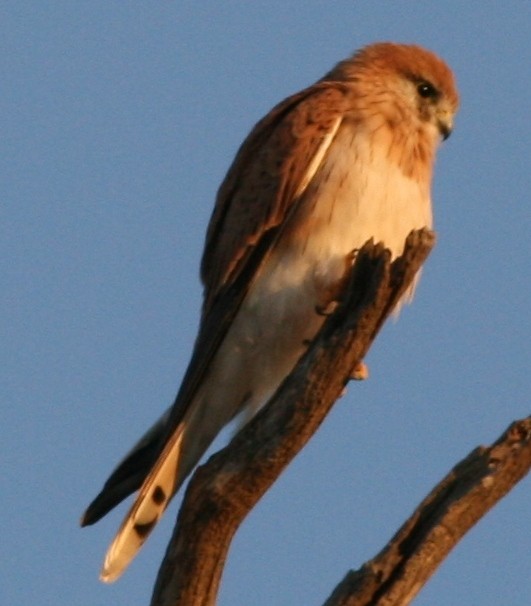Nankeen Kestrel
A species of True Falcons Scientific name : Falco cenchroides Genus : True Falcons
Nankeen Kestrel, A species of True Falcons
Botanical name: Falco cenchroides
Genus: True Falcons
Content
Description People often ask General Info
Description
The nankeen kestrel is a small, slim falcon 28 to 35 cm (11 to 14 in) long with a wingspan of 66 to 78 cm (26 to 31 in). The male weighs 121 to 195 g (4.3 to 6.9 oz) while the female weighs 115 to 273 g (4.1 to 9.6 oz). It has pale rufous upper-parts with contrasting black flight-feathers and is finely streaked white below, with a black subterminal band. The cere, eye-ring, and legs are yellow. The male has a pale grey crown and tail with a darker grey tear-mark, while the female and juvenile have a pale rufous crown and finely barred rufous tail. Plumage varies considerably in detail, and some birds can look very scruffy, but the slim build, small size and distinctive straight-winged hovering habit make identification easy. The only other Australasian raptors to hover are the elanid kites, which are much lighter in colour and a little larger, and the brown falcon, which is much larger and more heavily built, and hovers only with difficulty. Altogether, the nankeen kestrel looks just like a pale, less patterned, and smaller derivate of the Eurasian kestrel, which it indeed is (see Gloger's Rule, Bergmann's Rule). 
Size
35 cm
Colors
Brown
Black
Red
Gray
White
Life Expectancy
7 years
Nest Placement
Tree
Feeding Habits
Nankeen Kestrel primarily consumes insects, small birds, reptiles, and mice. They employ multiple hunting strategies, most notably perching in high vantage points and their distinctive hover-hunting over fields.
Habitat
Nankeen Kestrel resides in open habitats such as grasslands, savannas, and open woodlands, as well as modified landscapes like farmlands and urban areas. They favor temperate to tropical regions, using vantage points for hunting and nesting. Avoiding dense vegetation, they are adaptable to altitudes up to 3800 meters. Seasonal movements are driven by food availability.
Dite type
Carnivorous
People often ask
General Info
Feeding Habits
Bird food type
Distribution Area
A very common and easily seen raptor, the nankeen kestrel is found in Australia, New Guinea, and nearby islands, and is an irregular visitor to New Zealand. It occupies any type of land that is not too densely vegetated, but in particular temperate grasslands and open woodlands. In the tropical north and the sandy deserts of the west, it has a patchy and seasonal distribution. It can be seen in Western Australia on coastal cliffs and windy conditions. Also seen on phone lines and power lines. Like many Australian birds, it has no clear migratory pattern: in the grasslands of the south, established pairs are resident year-round, but many other birds migrate north during the austral winter, or roam the arid interior following food supplies. Typically seen singly or in pairs, they can aggregate into loose flocks of up to 30 when conditions are right. Pairs are typically monogamous and may or may not disperse to different areas during the non-breeding season. The nest is any convenient structure: a tree hollow, cliff ledge or disused corvid's nest, for example, and is not modified or added to by the kestrels. 
Species Status
Not globally threatened.
Scientific Classification
Phylum
Chordates Class
Birds Order
Diurnal Birds of Prey Family
Falcons and caracaras Genus
True Falcons Species
Nankeen Kestrel 